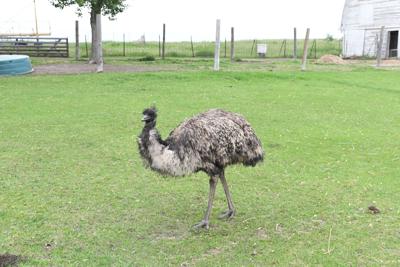ARCHER—A family north of Archer is never without emu-sment when it comes to their array of animals.
Their residence looks like a typical Iowa farm, but a closer look reveals a llama, a handful of peacocks, a pony, a mule and an emu.
Don and Dee Wagenaar have always had a love for animals, especially unique ones.
“We’ve always had some kind of exotic animal out here for about 30 years,” Don said.
Don has worked as a contractor and woodworker most of his life and has had an interest in unique animals since they settled on the farm in the 1980s. He became interested in emus after a trip to the Clay County Fair in Spencer.
“We went to the Spencer fair and there was a guy there who was trying to get people interested in raising them,” Don said.
They purchased a few of the flightless birds, with hopes of raising them for their meat, but the egg hatching was unsuccessful. A few years later, the man at the Clay County Fair quit the emu business and gave his breeding pairs to the Wagenaars. At one point, they had nine emus, but only one remains, a male who goes by the name of Sir Nopolis.
Emus can live for more than 30 years, so raising them takes some commitment. Sir Nopolis is around 20 years old. Indigenous to Australia, emus are part of the ratite bird family which includes kiwi, cassowary and ostrich. Emus can grow to 6 feet tall and weigh 110-120 pounds.
Emus can make good pets, but they can jump up to 7 feet high, so a tall fence is needed to keep them contained.
“They can run 30 miles per hour, and believe me, I know that,” Don said. “I’ve chased down a few of them.”
At certain times of the year, the emus have gotten restless and climbed up the fences, taking off down the road.
“The farthest I’ve gone to round one up was about eight miles,” Don said. “I grabbed my son’s minibike and was finally able to chase it down and throw a sheet over it.”
Emus do surprisingly well in Iowa’s climate, with their resting body temperature around 103 degrees.
“Unless it’s really bad weather, he’ll sit out in the snow” Don said about Sir Nopolis.
Sir Nopolis eats oats, grass and bugs, and in a fall, apples are his favorite treat.
When the Wagenaars had egg-laying emus, Dee would carve designs into the eggs and sell them for decoration. The eggs were about 5 by 2 inches big and have multiple layers, the outermost is a dark emerald green. The more layers are carved away, the paler in color the shell becomes. By carving at different depths, a three-dimensional effect can be achieved, and any sort of image can be carved into it. Dee has carved anything from the Green Bay Packers logo to Jon Wayne.
Dee had to wear a mask when carving the eggs as the powder that comes off is so fine it gets stuck in the lungs and causes issues if not prevented.
She also repurposes peacock feathers and makes other arts and crafts which she sells on her Facebook page D’Zynes by Dee R Wagenaar.
Dee and Don are accompanied on the farm by their daughter, son-in-law and 3-year-old grandson who gets the most enjoyment of the animals.
“It’s great that he gets to experience this,” Dee said. “Not every kid can say they grew up in a zoo.”
Don’s and Dee’s menagerie past and present has consisted of birds, a turtle, raccoons, sheep, several dogs and a pig. They currently have five peacocks with several eggs that recently were laid. The llama, named Burr, is the second generation of llamas they have had, and of course, there is Sir Nopolis, who is the last of his kind on the Wagenaar farm.
“A lot of people are like ‘Whoa, that’s crazy,’ when they see all the animals we have,” said Brittney Wagenaar, Dee and Don’s daughter. “But it’s just normal to us.”
